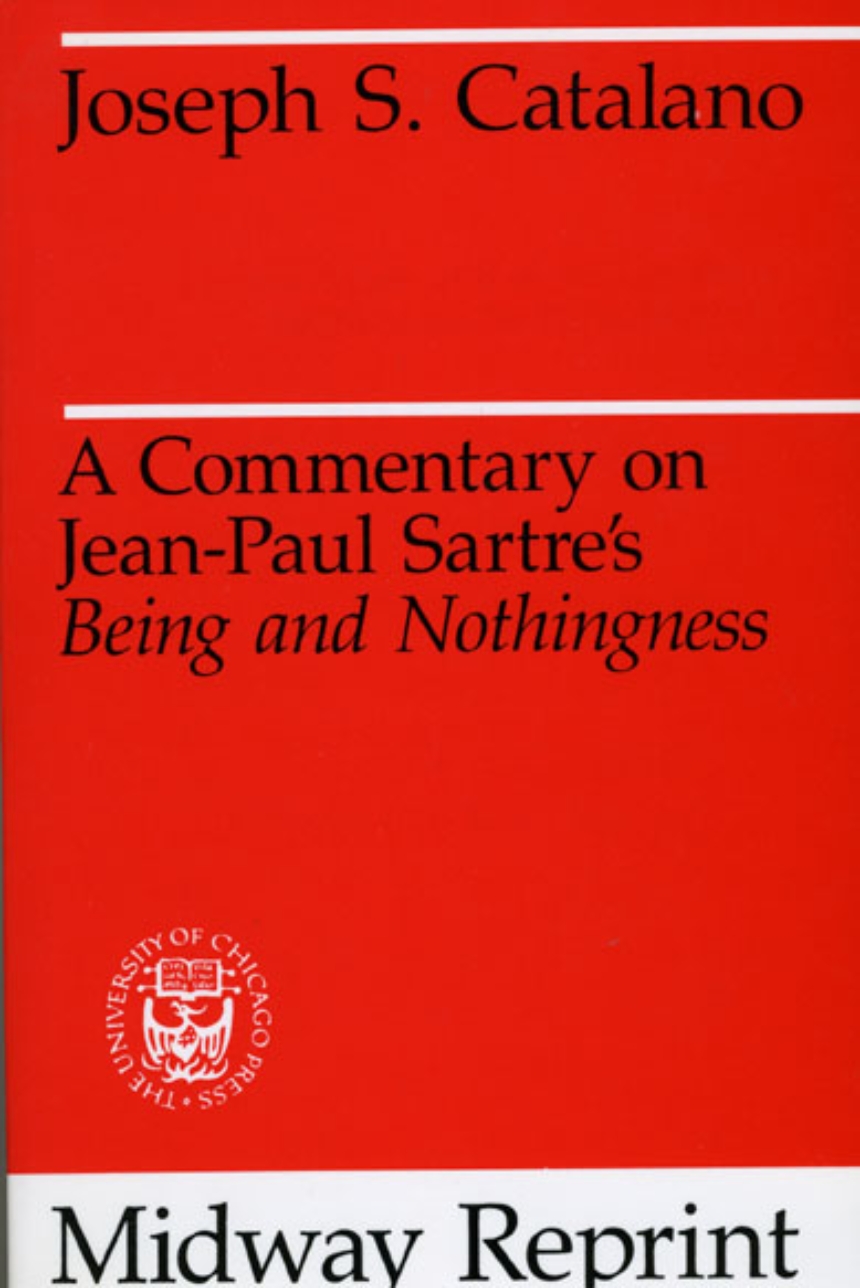A Commentary on Jean-Paul Sartre’s Being and Nothingness
"[A Commentary on Jean-Paul Sartre’s Being and Nothingness] represents, I believe, a very important beginning of a deservingly serious effort to make the whole of Being and Nothingness more readily understandable and readable. . . . In his systematic interpretations of Sartre’s book, [Catalano] demonstrates a determination to confront many of the most demanding issues and concepts of Being and Nothingness. He does not shrink—as do so many interpreters of Sartre—from such issues as the varied meanings of ’being,’ the meaning of ’internal negation’ and ’absolute event,’ the idiosyncratic senses of transcendence, the meaning of the ’upsurge’ in its different contexts, what it means to say that we ’exist our body,’ the connotation of such concepts as quality, quantity, potentiality, and instrumentality (in respect to Sartre’s world of ’things’), or the origin of negation. . . . Catalano offers what is doubtless one of the most probing, original, and illuminating interpretations of Sartre’s crucial concept of nothingness to appear in the Sartrean literature."—Ronald E. Santoni, International Philosophical Quarterly
Table of Contents
Preface to the Phoenix Edition
Preface
Acknowledgments
Background
The Title: Being and Nothingness
The Subtitle: An Essay on Phenomenological Ontology
The Introduction: The Pursuit of Being
I. The Phenomenon
II. The Phenomenon of Being and the Being of the Phenomenon
III. The Pre-Reflective Cogito and the Being of the Percipere
IV. The Being of the Percipi
V. The Ontological Proof
VI. Being-in-Itself
Part One: The Problem of Nothingness
1. The Origin of Negation
I. The Question
II. Negations
III. The Dialectical Concept of Nothingness
IV. The Phenomenological Concept of Nothingness
V. The Origin of Nothingness
2. Bad Faith
I. Bad Faith and Falsehood
II. Patterns of Bad Faith
III. The "Faith" of Bad Faith
Part Two: Being-For-Itself
1. The Immediate Structures of For-Itself
I. Presence to Self
II. The Facticity of the For-Itself
III. The For-Itself and the Being of Value
IV. The For-Itself and the Being of Possibilities
V. The Self and the Circuit of Selfness
2. Temporality
I. Phenomenology of the Three Temporal Dimensions
II. The Ontology of Temporality
III. Original Temporality and Psychic Temporality: Reflection
3. Transcendence
I. Knowledge as a Type of Relation Between the For-Itself and the In-Itself
II. Determination as Negation
III. Quality and Quantity, Potentiality, Instrumentality
IV. The Time of the World
V. Knowledge
Part Three: Being-For-Others
1. The Existence of Others
II. The Reef of Solipsism
III. Husserl, Hegel, Heidegger
IV. The Look
2. The Body
I. The Body as Being-For-Itself: Facticity
II. The Body-For-Others
III. The Third Ontological Dimension of the Body
3. Concrete Relations with Others
I. First Attitude toward Others: Love, Language, Masochism
II. Second Attitude Toward Others: Indifference, Desire, Hate, Sadism
III. "Being-With" (Mitsein) and the "We"
Part Four: Having, Doing, and Being
1. Being and Doing: Freedom
I. Freedom: The First Condition of Action
II. Freedom and Facticity: The Situation
III. Freedom and Responsibility
2. Doing and Having
I. Existential Psychoanalysis
II. "Doing" and "Having": Possession
III. Quality as a Revelation of Being
Conclusion
I. The In-Itself and For-Itself: Metaphysical Implications
II. Ethical Implications
Index
Preface
Acknowledgments
Background
The Title: Being and Nothingness
The Subtitle: An Essay on Phenomenological Ontology
The Introduction: The Pursuit of Being
I. The Phenomenon
II. The Phenomenon of Being and the Being of the Phenomenon
III. The Pre-Reflective Cogito and the Being of the Percipere
IV. The Being of the Percipi
V. The Ontological Proof
VI. Being-in-Itself
Part One: The Problem of Nothingness
1. The Origin of Negation
I. The Question
II. Negations
III. The Dialectical Concept of Nothingness
IV. The Phenomenological Concept of Nothingness
V. The Origin of Nothingness
2. Bad Faith
I. Bad Faith and Falsehood
II. Patterns of Bad Faith
III. The "Faith" of Bad Faith
Part Two: Being-For-Itself
1. The Immediate Structures of For-Itself
I. Presence to Self
II. The Facticity of the For-Itself
III. The For-Itself and the Being of Value
IV. The For-Itself and the Being of Possibilities
V. The Self and the Circuit of Selfness
2. Temporality
I. Phenomenology of the Three Temporal Dimensions
II. The Ontology of Temporality
III. Original Temporality and Psychic Temporality: Reflection
3. Transcendence
I. Knowledge as a Type of Relation Between the For-Itself and the In-Itself
II. Determination as Negation
III. Quality and Quantity, Potentiality, Instrumentality
IV. The Time of the World
V. Knowledge
Part Three: Being-For-Others
1. The Existence of Others
II. The Reef of Solipsism
III. Husserl, Hegel, Heidegger
IV. The Look
2. The Body
I. The Body as Being-For-Itself: Facticity
II. The Body-For-Others
III. The Third Ontological Dimension of the Body
3. Concrete Relations with Others
I. First Attitude toward Others: Love, Language, Masochism
II. Second Attitude Toward Others: Indifference, Desire, Hate, Sadism
III. "Being-With" (Mitsein) and the "We"
Part Four: Having, Doing, and Being
1. Being and Doing: Freedom
I. Freedom: The First Condition of Action
II. Freedom and Facticity: The Situation
III. Freedom and Responsibility
2. Doing and Having
I. Existential Psychoanalysis
II. "Doing" and "Having": Possession
III. Quality as a Revelation of Being
Conclusion
I. The In-Itself and For-Itself: Metaphysical Implications
II. Ethical Implications
Index
